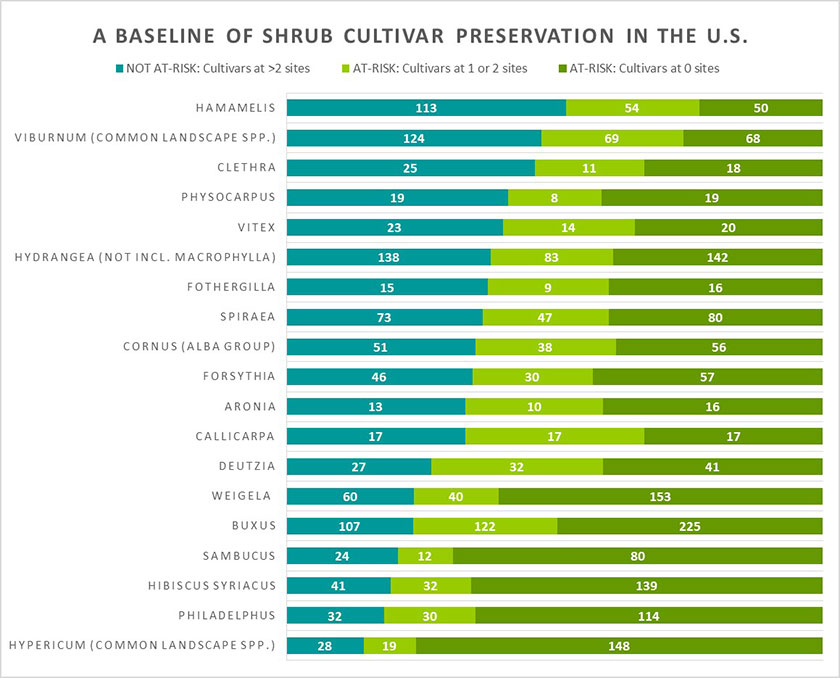Ornamental shrubs are the backbone of our planted landscapes. It’s hard to imagine American gardens without hydrangea, boxwood, or viburnum, but it’s easy to take these workhorse shrubs for granted. Plant trends come and go, but as the industry gets carried away with the hottest new thing, favorite old cultivars can slip out of commerce unnoticed. All we need is a new pest, disease, or drought to make us sit up and pay attention to these faithful companions. What if a forgotten cultivar carries the needed resistant genes?
With a desire to raise awareness of this issue and take action, the Chicago Botanic Garden set out to establish a baseline of cultivar preservation at public gardens in the United States. The research team compiled published cultivar names for 19 genera of ornamental shrubs and then surveyed more than 100 public gardens to locate them in living collections. Two-thirds of cultivars were found at two sites or fewer and were designated as potentially “at-risk.” Data by genus is available to view and download below. Each spreadsheet includes a list of all known cultivar names in the genus, the list of potentially at-risk cultivars, and some statistics from the study.
The Collections staff is now following up on each of the at-risk cultivars held onsite at the Chicago Botanic Garden: investigating nomenclature and history, checking the health of existing plants, propagating as needed, and forging connections with plant breeders, nurseries, and other gardens so that worthy cultivars don’t vanish from horticulture.
It’s true, however, that not every cultivar is worth keeping. Further research could include a review by experts in each genus to help prioritize preservation efforts. Some cultivar names may be synonyms or invalid, and more work is needed on nomenclature. Other cultivars may still be easy to find commercially, though they are not well-represented in public garden collections.
By sharing the following lists of at-risk cultivars, we hope to enable other public gardens as well as nurseries, plant breeders, and home gardeners to identify rare cultivars in their collections and take action to preserve valuable germplasm. Passionate gardeners are saving heirloom vegetables and heirloom roses…how about heirloom shrubs?
Thank you to the public gardens who participated in this study.
This project was made possible in part by the Institute of Museum and Library Services MA-30-14-0336-14.

More Information:
- The Importance of Preserving Cultivated Germplasm: A Baseline Assessment of 19 Shrub Genera at US Public Gardens
- Conclusions of a Plant Breeder Survey on Germplasm Preservation
Resources for Cultivar Preservation:
- Botanic Gardens Conservation International PlantSearch
- U.S. National Plant Germplasm System
- Cultivar.org
- American Public Gardens Association Plant Collections Network
- Plant Heritage


